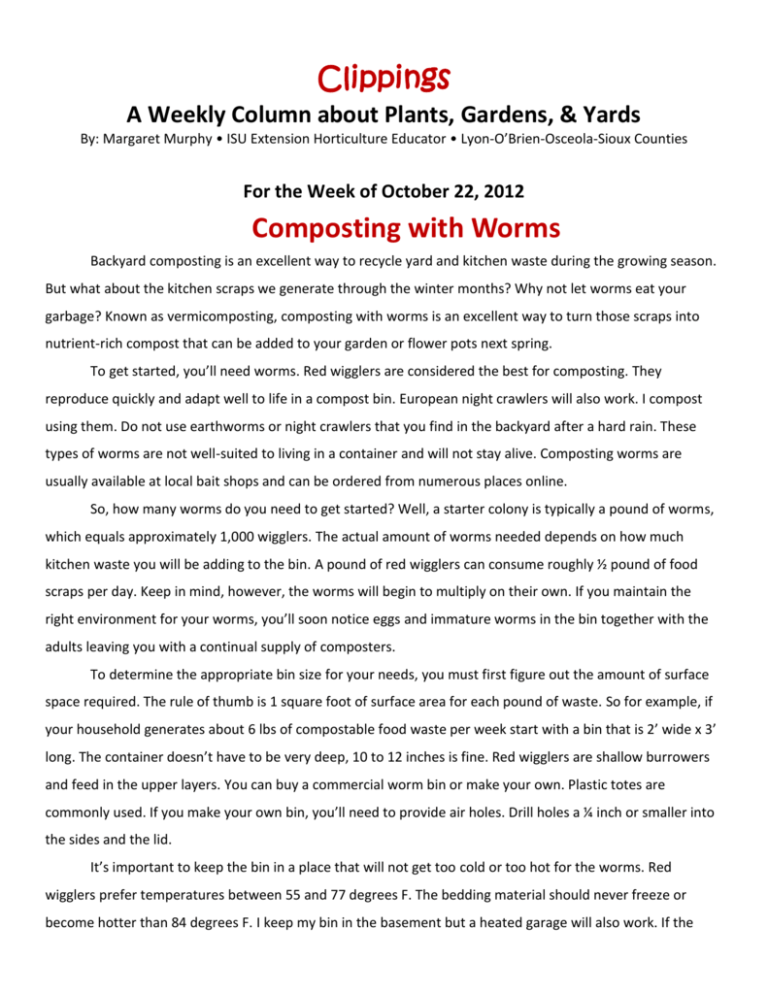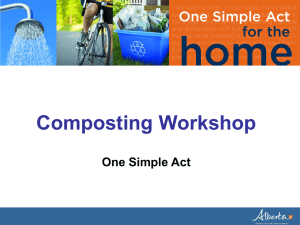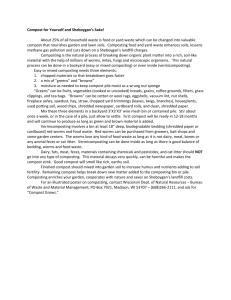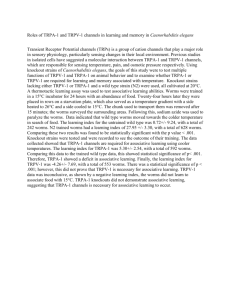For the Week of October 22, 2012 Composting with Worms
advertisement

Clippings A Weekly Column about Plants, Gardens, & Yards By: Margaret Murphy • ISU Extension Horticulture Educator • Lyon-O’Brien-Osceola-Sioux Counties For the Week of October 22, 2012 Composting with Worms Backyard composting is an excellent way to recycle yard and kitchen waste during the growing season. But what about the kitchen scraps we generate through the winter months? Why not let worms eat your garbage? Known as vermicomposting, composting with worms is an excellent way to turn those scraps into nutrient-rich compost that can be added to your garden or flower pots next spring. To get started, you’ll need worms. Red wigglers are considered the best for composting. They reproduce quickly and adapt well to life in a compost bin. European night crawlers will also work. I compost using them. Do not use earthworms or night crawlers that you find in the backyard after a hard rain. These types of worms are not well-suited to living in a container and will not stay alive. Composting worms are usually available at local bait shops and can be ordered from numerous places online. So, how many worms do you need to get started? Well, a starter colony is typically a pound of worms, which equals approximately 1,000 wigglers. The actual amount of worms needed depends on how much kitchen waste you will be adding to the bin. A pound of red wigglers can consume roughly ½ pound of food scraps per day. Keep in mind, however, the worms will begin to multiply on their own. If you maintain the right environment for your worms, you’ll soon notice eggs and immature worms in the bin together with the adults leaving you with a continual supply of composters. To determine the appropriate bin size for your needs, you must first figure out the amount of surface space required. The rule of thumb is 1 square foot of surface area for each pound of waste. So for example, if your household generates about 6 lbs of compostable food waste per week start with a bin that is 2’ wide x 3’ long. The container doesn’t have to be very deep, 10 to 12 inches is fine. Red wigglers are shallow burrowers and feed in the upper layers. You can buy a commercial worm bin or make your own. Plastic totes are commonly used. If you make your own bin, you’ll need to provide air holes. Drill holes a ¼ inch or smaller into the sides and the lid. It’s important to keep the bin in a place that will not get too cold or too hot for the worms. Red wigglers prefer temperatures between 55 and 77 degrees F. The bedding material should never freeze or become hotter than 84 degrees F. I keep my bin in the basement but a heated garage will also work. If the weather outside is moderate (between 55 and 80) the bin can be placed outside in a shady area alongside the house or garage. Worms are sensitive to light so make sure the bin is covered. It’s important to put proper bedding in the bin. Worms breathe through their skin so the bedding must hold moisture and allow for air circulation. The bedding will be consumed along with the food scraps so it also needs to be biodegradable and non-toxic to worms. Materials that work well include shredded newspaper (no shiny print), shredded computer paper, or old leaves. Wet down the bedding and wring out any excess water. Too much water can drown your worms. Fill the bin about 2/3 full with the fluffed bedding and add a shovelful of garden soil to supply grit for the worms’ digestion. Now you are ready to add the worms. Start adding food gradually until you see how fast it disappears and then adjust the amount accordingly. Feeding the worms once a week is usually sufficient. Acceptable food includes small scraps of vegetables and fruits, coffee grounds and filters, tea leaves and bags, bread, grains, and crushed egg shells (they also provide grit for the worms). Do not put in any meat, fish or dairy products, or oily foods. Worms are master composters. They can turn your food waste into rich, dark compost and worm castings in 3 to 5 months. Harvest the compost about 2 to 3 times a year. To make scooping the compost easier, harvest under a bright light as the worms will migrate toward the bottom of the bin to avoid the light. You can also do the “dump and sort” method. Dump the bin out on a tarp and create several small piles. Wait for the worms to move into the center of the pile. Remove the compost until you reach the worms and then return them to the bin along with any eggs. Refill the bin with fresh layers of moisten bedding and food when finished. Vermicomposting is a great winter project and one that can get kids involved with composting and recycling. For more information on vermicomposting, feel free to contact me at mmurphy@iastate.edu, by phone at (712) 754-3648 or through your local County Extension office. Additional information was provided by the following publications: Clemson Cooperative Extension, Worm Composting, Oklahoma Cooperative Extension Service, Vermicomposting-Composting with Worms, Texas AgriLife Extension Service, Vermiculture: Worm Composting, and the University of Nebraska-Lincoln Extension, Vermicomposting: Composting with Worms. ###








